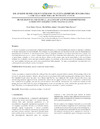Identificador persistente para citar o vincular este elemento:
https://accedacris.ulpgc.es/jspui/handle/10553/106039
| Title: | Análisis biomecánico y clínico de una nueva geometría de barra para la cirugía correctora de pectus excavatum | Other Titles: | Biomechanical and clinical analysis of a new bar geometry for corrective surgery of pectus excavatum | Authors: | Martel Fuentes, Oscar Perez Alonso, David Yánez Santana, Manuel Alejandro |
UNESCO Clasification: | 3314 Tecnología médica | Keywords: | Biomecánica Pectus excavatum Ensayo clínico Biomechanics Pectus excavatum, et al |
Issue Date: | 2019 | Publisher: | División de Publicaciones UIS (universidad industrial de Santander) | Conference: | XIV Congreso Iberoamericano de Ingeniería Mecánica - CIBIM 2019 | Abstract: | El pectus excavatum se caracteriza por el hundimiento del pecho y su solución quirúrgica consiste en introducir una barra en la caja torácica para elevar el esternón. Sin embargo, este procedimiento está asociado con un riesgo de desplazamiento postoperatorio de la barra. Se analizaron la barra curva de longitud estándar y una nueva barra más corta y plana. Los resultados mostraron que en la barra estándar aparecieron fuerzas y momentos desestabilizantes, que no aparecieron con la nueva barra. Además, se llevó a cabo un ensayo clínico en dos grupos, uno con la nueva barra y otro con la barra estándar. Los resultados fueron similares en ambos grupos, sin embargo, se dieron dos casos de desplazamiento de barra con barra estándar, mientras que con la nueva geometría no hubo ninguno. Por tanto, recomendamos una barra más corta y plana para la corrección del pectus excavatum. Pectus excavatum is characterized by the sinking of the chest and its surgical solution consists of introducing a bar in the rib cage to elevate the sternum. However, this procedure is associated with a risk of postoperative displacement of the bar. The standard length curve bar and a new shorter and flat bar were analyzed. The results showed that forces and destabilizing moments appeared in the standard bar, which did not appear with the new bar. In addition, a clinical trial was conducted in two groups, one with the new bar and the other with the standard bar. The results were similar in both groups, however, there were two cases of displacement of bar with standard bar, while with the new geometry there was none. Therefore, we recommend a shorter and flat bar for the correction of pectus excavatum. |
URI: | https://accedacris.ulpgc.es/handle/10553/106039 | ISBN: | 978-958-52438-6-6 | Source: | XIV CIBIM-CIBEM. Actualidad de la Ingeniería Mecánica en Iberoamérica Atualidade da Engenharia Mecânica Ibero-América / Manuel del Jesús Martínez (ed.), p. 238-243 |
| Appears in Collections: | Actas de congresos |
Page view(s)
356
checked on Nov 23, 2024
Download(s)
148
checked on Nov 23, 2024
Google ScholarTM
Check
Altmetric
Share
Export metadata
Items in accedaCRIS are protected by copyright, with all rights reserved, unless otherwise indicated.
